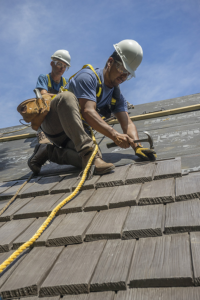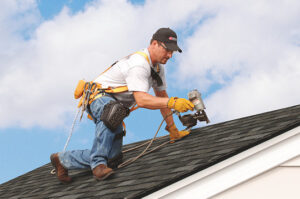A roofer, also known as a roofing mechanic or roofing contractor, installs, repairs, and replaces roofs. West Chester Roofer works on residential homes, commercial buildings, and other construction sites. They usually collaborate with teams and must have good customer service skills to communicate with clients. They often attend meetings with management and salespeople. They also undergo yearly safety training to stay current with the latest techniques.

Roofers operate in both private residences and commercial structures. They have to be able to withstand being outside in the weather for the majority of the time that they are working on the roof. Roofers tend to have very strong Realistic interests, which is advantageous because the work often entails solving problems with hands-on experience.
Roofers work in various settings, including private homes and commercial buildings. Most of the time, they are outside working on the roof, so they must be comfortable with being exposed to weather elements. People who choose to be roofers have very strong Realistic interests, which is a good thing because this career often involves hands-on problem solving.
The career path to becoming a roofer usually includes completing of four-year apprenticeship program. Then, they must complete a series of on-the-job training and formal technical and practical training.
Roofers are responsible for repairing, installing, and maintaining roofs for both residential and commercial properties. They install shingles, vapor barriers, and insulation to protect buildings from rain, snow, sunlight, and other weather conditions. Depending on the type of roofing, roofers may also repair leakage and rough spots. They typically work full-time and may receive additional compensation during peak season.
To be a successful roofer, you must be able to follow instructions and understand blueprints or diagrams. You also need to be able to read and write well enough to communicate with other crew members about job requirements. The ability to stand on ladders and scaffolding for long periods of time is important, as is the ability to use hand tools such as shingle cutters and roofing hatchets. Many roofers also need to be able to drive to jobs in trucks and other vehicles.
You need to be able to read blueprints or diagrams and follow directions in order to work as a roofer. Additionally, you must be proficient in reading and writing so that you can discuss job requirements with other crew members. The capacity to use hand tools like roofing hatchets and shingle cutters, as well as the ability to stand on ladders and scaffolding for extended periods of time, are crucial. A lot of roofers also need to be able to drive trucks and other vehicles to their jobs.
A roofer often works as part of a team, although some are self-employed and freelance. They are also responsible for performing various tasks to complete roofing projects on schedule and within budget. They may need to estimate materials and labor for each roofing job, and provide price quotes to customers.
They may also be responsible for setting up scaffolding and ladders for safe access to the roof. In addition, they may need to sand, scrape, or remove old roofing materials and debris. They may need to cut or nail tar sheets, and they can be responsible for installing or repairing roof gutters. They can also re-slate or tile roofs, fit skylight windows, and replace lead sheeting and cladding.
Roofers are usually required to have a high school diploma or GED certificate, but many employers prefer to offer on-the-job training. Whether you want to start your career as a roofer or are looking for an entry-level position in the trade, it is vital to get training and experience under the guidance of a mentor. You can also attend seminars and workshops to keep your skills up to date. You can even pursue certification from local or national organizations to improve your employment opportunities.
Although a high school degree or GED is typically required, many employers would rather offer on-the-job training to potential roofers. It is essential to obtain training and experience under the supervision of a mentor whether you want to begin your career as a roofer or are searching for an entry-level position in the industry. Attending seminars and workshops is another way to stay current with your skills. To increase your job prospects, you can even work toward certification from regional or national organizations.
Roofers play a critical role in building structures. They install new roofing systems and repair existing ones. They must be able to read and follow technical plans, as well as understand how different materials work together. This career is ideal for detail-oriented people who enjoy working with their hands. It also requires the ability to work at heights, as roofers often need to climb ladders and scaffolding in order to complete their work.
Education and training requirements for roofers vary by location. Many learn the trade on the job as helpers for experienced craft workers, while others go to vocational school or an apprenticeship program. The latter usually lasts for three years and combines at least two thousand hours of on-the-job training with 144 hours of classroom instruction. In addition to learning about different roofing materials and techniques, apprentices are taught how to use tools, perform basic arithmetic, and read blueprints.
Location-specific requirements for roofers’ education and training differ. While some choose to attend vocational schools or participate in apprenticeship programs, many learn the trade on the job by assisting more seasoned craft workers. The latter typically lasts three years and comprises 144 hours of classroom instruction along with at least two thousand hours of on-the-job training. Apprentices receive instruction in tool use, basic math, and blueprint reading in addition to learning about various roofing materials and techniques.
Those who want to become roofers must be at least 18 years old and in good physical condition. They should also have good hand-eye coordination and be able to think quickly on their feet. A high school diploma is helpful, and classes in shop, basic mathematics, and mechanical drawing may be beneficial.
After gaining experience in the field, a roofer can advance to become a journeyman roofer or a supervisor. They can also start their own roofing business or become a member of a union that offers advancement opportunities. Roofers who are part of a labor union may be eligible for positions as shop stewards, apprenticeship instructors, or union hall officers.
While most roofers do not need a license to work in their field, they may be required to register with local authorities before starting work on a construction project. There are also specific requirements for those who work with asbestos. In addition, some states require a home improvement registration or construction supervisor license for roofers who work on existing buildings. These licenses can be restricted to one and two-family dwellings or can cover structures up to 35,000 cubic feet. In addition, some states have requirements for safety equipment and the use of ladders.
Roofers often work long hours. They might start their day at 6 a.m. to make it to their job sites in time to begin work. If they’re in hot weather, they may need to take a break from 11 a.m. to 4 p.m. to avoid heat stress. If they work as part of a team, they’ll also need to coordinate their schedules with other members. Some roofers are self-employed and decide to set their own hours, but this isn’t a good choice for everyone. It’s much better to be an employee when working as a roofer since you can see the results of your work on a daily basis, which can be motivating.
Working as a roofer can be very rewarding. If you have the stamina to work outdoors, use heavy materials and tools, climb ladders, and withstand the elements, this is a great career choice for you. You’ll definitely get a workout and you’ll be helping people protect the things they love. The only thing better than this career is finding another one that allows you to do all of these things and still have time to spend with your loved ones.



